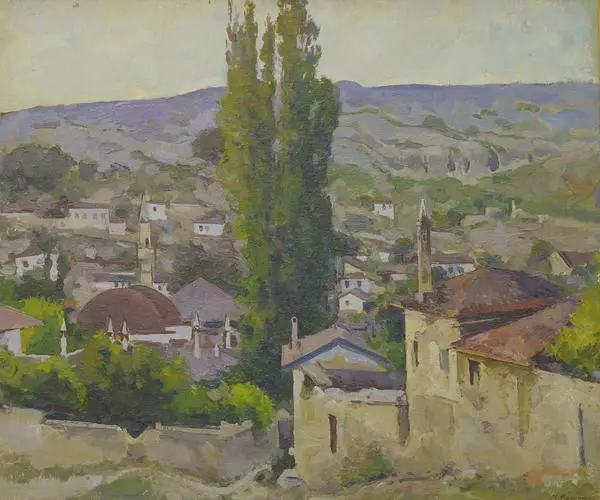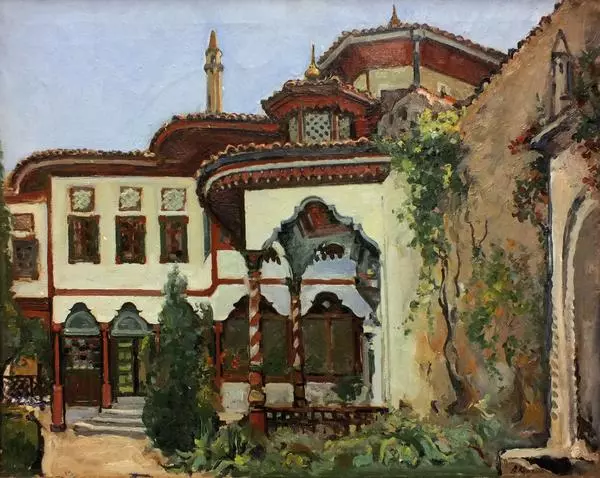The creative fate of Alexander Kuprin is typical of most artists who lived and worked at the turn of the 19th – 20th centuries. Having gone through the fascination with various experimental trends that the period was rich in, by the 20s of the past century, Alexander Vasilievich had left the creative group ‘Jack of Diamonds’ and returned to the traditional realistic style, which can be seen on the canvas Bakhchisarai noon, created by the master in 1935 year.
Thus, Russian painting found another excellent landscape painter, successor of the tradition of the Russian classical school and a worthy follower of such recognized masters of the 19th century as, for example, K. Korovin, K. Yuon and I. Dudin, who were his teachers.
His father, a school teacher, could not regularly pay for his son’s education, therefore, simultaneously with his studies first at the Voronezh Art School and then at the Moscow School of Painting, the young artist had to work hard to sustain himself.
It is likely that it was during that very difficult period of his life that Alexander Vasilyevich undermined his health, which is why much later due to medical reasons almost every year he had to spend a long time in the south, in the Crimea. Thus, it is not surprising that many landscapes by the artist are dedicated to the nature of that peninsula.
The Crimean mountains, steppes, urban views, the sea became the most important topics in the art of the almost complete namesake of the famous Russian writer. Kuprin’s works embodied those painting principles to which the artist came, having ‘outgrown’ enthusiasm for Futurism. In the master’s Bakhchisaray landscapes, the changeable, vibrant southern nature merges with the architecture of the ancient city.
On the canvas Bakhchisaray Noon, the Crimean mountains and view of city streets with ramshackle clay houses and a dilapidated wall do not contradict each other, on the contrary, they are inextricably linked. The artist manages to breathe life into the urban landscape filled with bright sunlight and the colours of the midday nature.
Kuprin’s fascination with Cubism, did not pass in vain: his painting style is distinguished by contrast and intensity of colour, geometricity and sometimes even outright schematic forms. Actually, these qualities distinguish Alexander Vasilyevich’s works from the canvases of other landscape painters of that era.
In the Crimea, Kuprin finds many different sources for inspiration: those are both traditional Muslim architecture, whose images capture history, and industrial landscapes and views of the beautiful nature of the peninsula.
Thus, Russian painting found another excellent landscape painter, successor of the tradition of the Russian classical school and a worthy follower of such recognized masters of the 19th century as, for example, K. Korovin, K. Yuon and I. Dudin, who were his teachers.
His father, a school teacher, could not regularly pay for his son’s education, therefore, simultaneously with his studies first at the Voronezh Art School and then at the Moscow School of Painting, the young artist had to work hard to sustain himself.
It is likely that it was during that very difficult period of his life that Alexander Vasilyevich undermined his health, which is why much later due to medical reasons almost every year he had to spend a long time in the south, in the Crimea. Thus, it is not surprising that many landscapes by the artist are dedicated to the nature of that peninsula.
The Crimean mountains, steppes, urban views, the sea became the most important topics in the art of the almost complete namesake of the famous Russian writer. Kuprin’s works embodied those painting principles to which the artist came, having ‘outgrown’ enthusiasm for Futurism. In the master’s Bakhchisaray landscapes, the changeable, vibrant southern nature merges with the architecture of the ancient city.
On the canvas Bakhchisaray Noon, the Crimean mountains and view of city streets with ramshackle clay houses and a dilapidated wall do not contradict each other, on the contrary, they are inextricably linked. The artist manages to breathe life into the urban landscape filled with bright sunlight and the colours of the midday nature.
Kuprin’s fascination with Cubism, did not pass in vain: his painting style is distinguished by contrast and intensity of colour, geometricity and sometimes even outright schematic forms. Actually, these qualities distinguish Alexander Vasilyevich’s works from the canvases of other landscape painters of that era.
In the Crimea, Kuprin finds many different sources for inspiration: those are both traditional Muslim architecture, whose images capture history, and industrial landscapes and views of the beautiful nature of the peninsula.







